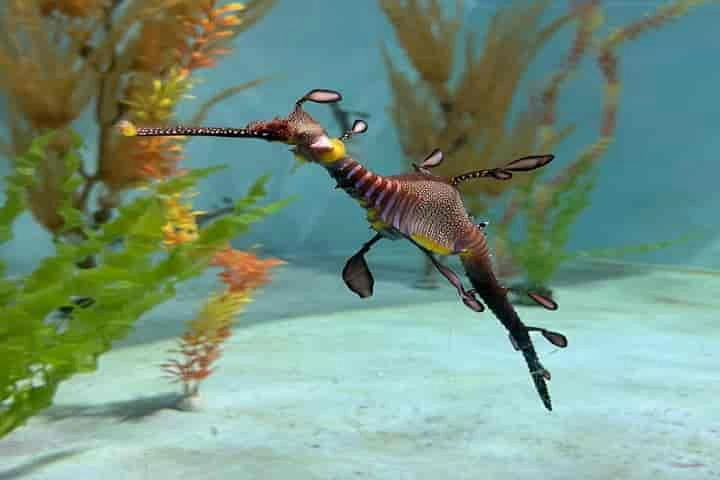Swimming in the waters, the marine fishes, sea dragons look stunning while their colours dazzle, drawing the entire limelight on themselves! Yet, according to a report in sciencealert.com, there is something unique and strange about them – they don’t have any teeth, ribs and the shape of the spine is curved and twisted.
Intrigued, the scientists have now deciphered through the study of their genes as to what makes them distinctive. Their genomes have plenty of DNA that fast-tracked their evolution while at the same time the set of genes that help in creation of teeth, nerves and facial characteristics in other beings are not present.
The team which studied the sea dragons’ genomes wrote in their paper that their study has "lifted a veil on the evolution of sea dragon-specific traits" and "revealed intriguing evolutionary facets of this unusual vertebrate family, the Syngnathidae, as a whole”.
Today's Ocean Beauty : Weedy Sea Dragon!
IG@tomsunderwaterphotography#ocean #nature #SundayMorning #SundayFunday pic.twitter.com/j6VPGqs7yF
— Oceans Beauties (@OceansBeauties) December 22, 2019
These animals hail from a family which includes sea horses and pipefish – the Syngnathidae – well-known in the scientific world for having developed male pregnancy.
Talking about them Clayton Small remarked: "This group is just cool for a number of different reasons. But sea dragons are oddballs in a group of already oddball fish."
Small is an evolutionary genomics researcher at the University of Oregon and led the study along with fellow researcher Susan Bassham.
With a view to understand the peculiarities of sea dragons, the two along with the team sequenced the genomes of two types of these creatures. One was the weedy or common sea dragon while the other was the leafy sea dragon. These two types are found in cool waters off the southernmost coasts of Australia.

Leafy Sea Dargon (Pic. Courtesy Twitter/@mnzoo)
The sea dragons remain elusive as they remain hidden under their leaf-like fronds in rocky reefs that are covered with kelp. There are only three species of these fishes and the third ruby sea dragon not covered by this study was seen for the first time in the wild in 2017. While all of them are bright and colourful, the leaf-like parts are missing from the ruby sea dragons possibly due to evolution.
Researchers feel that evolution of the unique features of sea dragons took place at a rapid pace – in about 50 million years – when they parted ways with the sea horses to begin a new family.
While this aspect became clear what still remained a puzzle was their distinctive look. To find more about it the researchers from the University of Oregon collaborated with the Birch Aquarium at Scripps Institution of Oceanography, and the Tennessee Aquarium, to study in detail the sea dragons they had raised in captivity.
This collaboration yielded results which showed that when juxtaposed with seahorses and pipefish, sea dragons had a huge number of transposons – repetitive DNA sequences – which are also called jumping genes.
Being able to move around in the genome, these transposons make rapid changes in the genes elucidating why sea dragons evolved so fast.
In contrast to their two distant relatives, namely sticklebacks and zebrafish, the weedy and leafy sea dragons don’t possess a large quantity of genes that play a vital role in other vertebrates in creating and shaping of teeth, facial features, limbs and parts of the central nervous system.
Whether the loss of these vital genes was compensated by elongated facial features and beautiful frills in the sea dragons will require in depth study and research of the evolutionary history of these creatures and their other relatives.
BEAUTIFUL leafy sea dragon. It's not a Pokémon, it's real.
These guys live off the coast of Australia, and the 'leafy' growths are perfect for camouflage in seaweed.
Video from Lisbon Aquarium (
Imgr Mothgaze) pic.twitter.com/pyZyyUNm2X
— Jan Freedman (@JanFreedman) September 18, 2021
This is not all as during their study the researchers found out in a foot-long adult male weedy sea dragon specimen ornamental appendages that had probably evolved from spines. Remarking about this Bassham said: “We could see that the support structures for the leafy paddles appeared to be elaborations of spines [with fleshy appendages] added to the ends.”
It was also observed that these bony supports were different from those found in the fins of bony fish. In the latter it was hardened, ossified bones and in the case of sea dragons they seemed to be solidified by collagenous tissue.
Who knows what other secrets are hidden in the genes of these unique creatures?
Details of this study were published in PNAS.
Also read: Scientists stunned by similarity between human and octopus brain





















